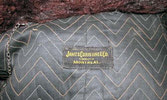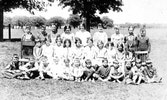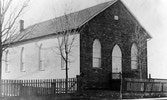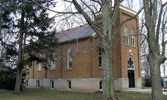Bearskin coat was a sign of congregation's respect
By Shawn Loughlin
A story of history, traced by local churches and a warm, uniquely Canadian coat, had its humble beginnings in the Brussels, Cranbrook and Ethel communities.
“From the early 19th through to the mid-20th century in Canada, there was a gift [other perhaps than a purse of money] that revealed the high esteem in which a congregation regarded its minister. A bearskin coat was one that cost the congregation a considerable expense,” reads an entry of Museum Musings, a writing of the National Presbyterian Museum, located on Broadview Avenue in Toronto.
The article goes on to explain that the national museum collection’s first-ever bearskin coat, a black bear coat, came by way of Rev. William Arman Williams who, between 1927 and 1939, had been called to serve the pastoral charge that comprised the two Knox Presbyterian Churches in Cranbrook (congregation established in 1855, church built in 1865) and Ethel (church built in 1927).
The coat was manufactured by Montreal’s James Coristine & Co. Limited, a company founded in 1869 by James Coristine. The company sold a variety of fur products over the years, but found its greatest success with beaver fur top hats around the turn of the 20th century.
The Williams family’s journey began in 1880, when Williams was born in Wales. He graduated in Wales’ Presbyterian Bala College, was ordained in 1913 and served as a minister in Wales before moving to the United States in 1921, serving in Bangor, Pennsylvania from 1921 to 1926.
After serving briefly in Oxford, Iowa, Williams moved to Ontario and began his service in Huron County.
The coat, described as a “prized possession of the pastorate” was then passed on through several generations after first being gifted to Williams by congregations in Cranbrook and Ethel.
The generous gift was given not just out of admiration, said the Williams family, but out of necessity.
“The pastoral charge realized that its new Welsh minister would need to keep warm on his pastoral duties, so they took a collection and presented him with a new bearskin coat,” reads the description given by the Williams family when the coat was donated to the Toronto museum. “He wore it while driving horse and cutter in the snow belt of Huron County when roads were impassable for travel by car.”
In 1939, after serving in Cranbrook and Ethel for over a decade, Williams moved on to serve the pastoral change of Valetta, Ontario and New St. Andrew’s in Dover Township.
Williams passed away in 1967, but not before the coat was passed to his son, Ivor, who had spent some time growing up in Huron County.
In an interview with The Citizen, from his home in London, Ivor, now in his 90s, says he remembers those cold, horse-drawn trips around Huron County, saying that he always remembered the coat as being a warm respite from the brutal local winters.
Ivor was educated at Cranbrook Public School, an experience he remembers fondly.
The building, he says, was two rooms, but only one was used as a classroom. He remembers a number of well-educated, successful pupils making their way through the school’s doors.
Ivor was among those successful students, serving as the managing editor of The London Free Press for a number of years and becoming the editor of The Regina Leader-Post in 1973 before retiring in 1988.
After retiring, Ivor served as a contributing editor and regular columnist for The Presbyterian Record from 1989 to 2000. During that time he also served as chair of The Record’s committee for one year.
Before Ivor began his work as one of the country’s foremost journalists, however, he served his country as a fighter pilot in the Royal Canadian Air Force during World War II.
Ivor was interviewed for The Memory Project, in which he recounted joining the Air Force the day after he turned 18. Living with his father William and mother Annie in Tilbury, he travelled to Windsor in order to enlist.
When he arrived in Windsor to enlist, he found himself in front of a man whose wedding his father had presided over just days before.
The man told Ivor, “You’re old enough, you’re smart enough – you can be a pilot.”
In The Memory Project, Ivor remembered his first flight. When his instructor allowed him to fly solo for the first time, Ivor said he remembered shouting, cheering and clapping his hands, happy to be in the air by himself for the first time.
Ivor was stationed in Digby, a northern community of Yorkshire in England. He served with the 443 Squadron as a Spitfire pilot.
During his time as a pilot, Ivor said one of the most harrowing experiences he’d had was a mid-air collision, something very few people survived.
Ivor says he had flown the last patrol at night on June 5, 1944 in south England. He described the experience as “the most fantastic sight that I will ever see”. He had flown a number of missions prior to D-Day, but on June 6, 1944, he assisted in patrolling Juno Beach, warding off enemy fighters and providing cover for ships, The Memory Project states.
It wasn’t until years later that Ivor would pass his father’s bearskin coat onto his son, Garry, who would then donate it in 2012 to the National Presbyterian Museum, where it now remains.
The family still has roots in Huron County. Ivor’s sister, Eluned (Williams) McNair passed away at Brussels’ Huronlea Home for the Aged on June 20, 2014, just five days short of her 100th birthday. She and her husband Stuart had farmed near Cranbrook until Stuart’s death in 1972.
Eluned then moved into Brussels, living in the same house in which her mother and father lived during their time in Brussels. Eluned left behind a beloved daughter, Myra Henry, and her husband Bill, who now live in Goderich.
Born in Wales in 1914, Eluned had been a teacher at Union School on Cranbrook Road for a number of years before the country schools merged and she continued her teaching career at Grey Central Public School, now North Woods Elementary School.
Her final resting place is now Brussels Cemetery, just south of the village.







